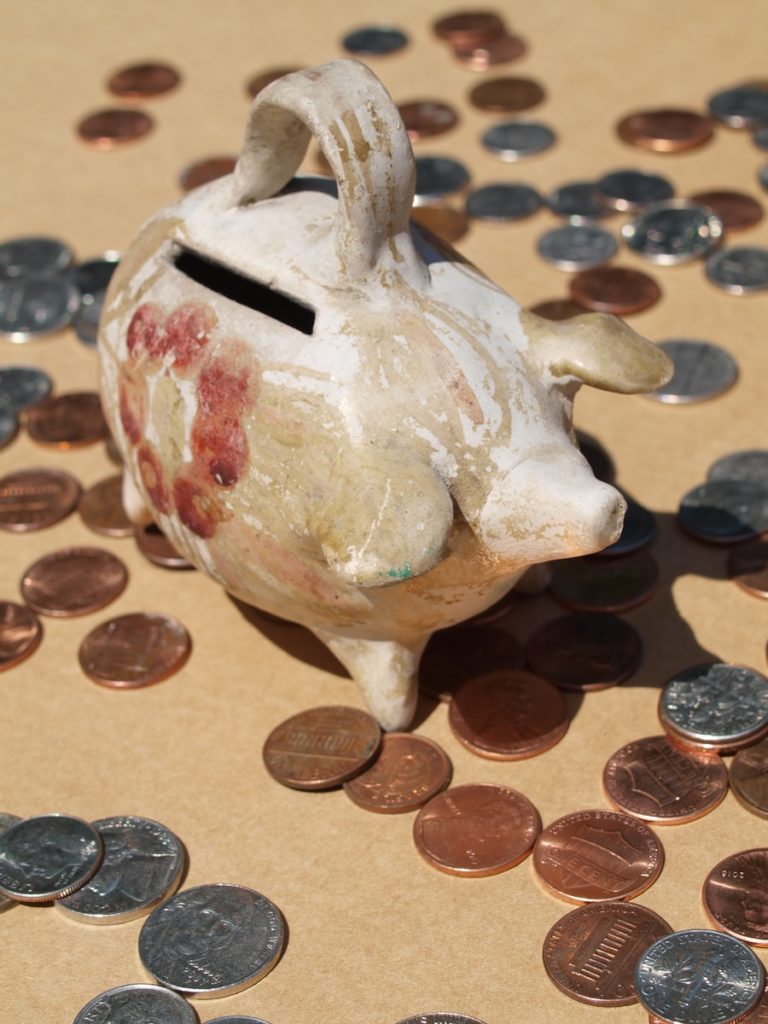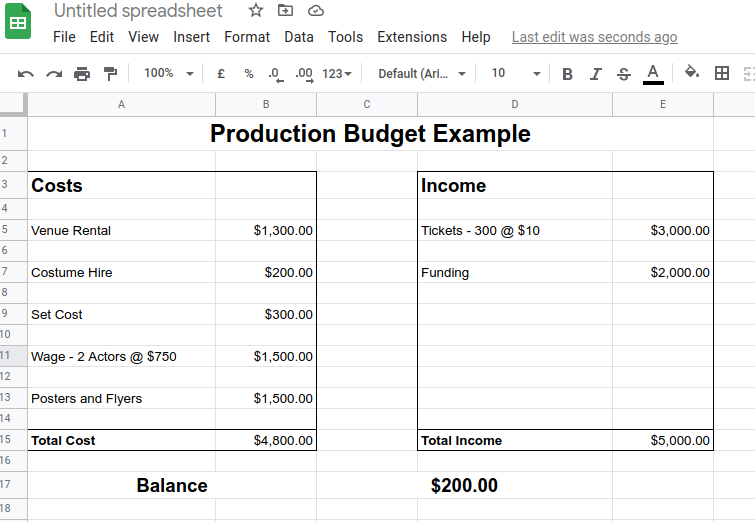
Budget 101: The Basics of Show Budgets
Getting started with budgets for theatre producers
Introduction
There is nothing quite like the excitement of those first conversations about staging your production.
People dream big, and the ideas grow more and more outrageous. A team of excited creatives ready to change the world!
Yet nothing deflates that balloon of enthusiasm like the mention of making a budget. All those people who wanted to help are suddenly nowhere to be found.
Maybe it’s the reality of accepting that everything costs money. But, on the other hand, perhaps it’s just the numbers. Or maybe you don’t know where you’d even start.
Whichever it is, this article sets out to break budgeting down in an easy to understand way.

It explains exactly what makes up a budget, how to make one for your show, and gives tips to make it easy to manage.
Note: There is no rocket surgery here, but we’ve started with the basics to keep this simple and easy for everyone. Feel free to skim-read and checkout Budget 201 (when it comes out).
What is a budget?
Most people will understand budgets from their daily lives but let’s start with the basics.
A budget is a tool that helps you plan and keep track of the financial aspects of your production.
It records how much money you spend on the show and how much income you get from it. Then by comparing the two figures, it tells you if you owe money or have some leftover.
It can be broken down into three parts.
Your spending
The money you spend is referred to as your costs or expenditure.
Your expenditure includes things like:
- Venue hire
- Set and Costumes
- Marketing and Promotion
- Wages
All of the costs are added up to get your total expenditure.
Imagine it like going to a restaurant with friends. The list of dishes on the receipt items is your cost if you pay the total.
Your income
The money you get for putting on the production is your income.
Typical production income items are:
- Ticket sales
- Funding
- Sponsorship
- Donated time and equipment
Some of these items don’t come as actual cash, but we’ll say they have an easy cash value for now.
We add up all the income to get your total income.
Imagine this like your friends are all giving you cash because you paid the bill. Adding up the money each person gave you (your share from your bank account) gives you the total income.

The balancing act
The final part of the budget is comparing the two numbers.
When you do this, there are three outcomes:
- your income is higher than your costs – Money left over
- your income is the same as your costs – Balanced
- your income is smaller than your costs – You owe money
The first two are OK. The third, not so much.
Imagine the restaurant again. It’s OK if your friends give you enough or more than the cost of the bill, but if you get less, you’re out of pocket.
If you cover your costs in a theatre production, that’s a success, and you should be happy.
Following the map
Before anything else, your budget is a plan. Think of it like a map that you make to help you get to the end of your production successfully.
You use it to plan the route you’ll be taking and make sure you follow it. You’ll also use it to navigate a path around unexpected events or even change plans as you go.
For a budget to help you do this, you need to:
- Make it before you start your project
- Make it as detailed as possible
- Understand what you can change if things don’t go to plan
For more on planning check out this article.
Where do I get the figures?
This is the time that many people start to worry. Most folks get the income vs costs thing but ask, “where the hell do I get the numbers to put in this thing?”
The answer is research.
Experienced producers don’t have some unique ability to magically create budget numbers. Instead, they call people and ask. Or they look it up on the net.
The key to effective budgets is the information you make it with. Experience may allow you to make a good guess at numbers for a draft, but you need good inputs to make the plan any use.
To find out what your venue will cost, you’ll need to contact them. Contact a few to compare costs. Think about which one is the best place to hire before you decide. Then put that cost in your budget.
The same for costume hire, set building or rehearsal space.
To work out what wages will cost, you could decide what you are prepared to pay and choose the people who’ll work for that figure. Or you could find the people you want and negotiate a figure that they’ll work for.
Start with the best estimate you can get. Then as soon as you can, replace them with real numbers, so your budget reflects what’s actually happening at the time.

What about the audience?
With some work, you can get a good number for your plan for most things. With income like funding, you’ll know exactly what they’ve paid you. For donated goods, you can estimate what they are worth in cash.
Audiences are harder. Six months out from your opening night, how do you know how many people will come?
You need to make an estimate. Most often, this comes as a percentage figure which refers to the proportion of all the tickets you have that you expect to sell.
There is a standard number for this percentage, but it does depend on your production and location.
A good number for a small production is between 25-40%. That means 3-8 performances and no more than 800 tickets in total.
Debut producers should choose the smaller end of the range (25-30%). If you’ve done this before, you’ll know a little better what to expect.
Many other elements can affect this estimate. A later article will take a deeper look at what you might consider making a more informed estimate.
OK, that’s a lot of numbers.
The folk who hate maths are ready to switch off about this time. Yet you can manage a budget with very little actual maths these days.
If you have a computer with access to the internet, you can access a free tool that makes keeping your budget updated a breeze. A spreadsheet – Google Sheets, to be exact.
You can put your costs in a list and, with a bit of prep, the sheet will keep track of the total for you. Put your expenses on one side of the page and your income on the other. Then compare the sums, and you’re done.
If you change anything, the whole sheet updates, and you don’t need to do anything.
Why Google Sheets?
You can choose whichever tool you like. You have used Excel or Numbers on Mac. Even some financial planning apps and programs. They all do the same thing, but Sheets has some significant advantages.
The things that make Google Sheets such a good option are:
It’s free and easy to use
It’s online, so you can access it anywhere
You can collaborate simply with others and share it
Being online it’s backed up
Google Sheets is superb and among our recommended tools for any producer.
To learn the basics about using Sheets, visit this tutorial.

Setting up your Google Sheet
The simplest way to use a spreadsheet is to make two lists, as briefly described above.
The first list is your spending.
You could describe the cost in Column A and then the cash value in Column B. Add each new cost to the list as they come in. Once the list gets longer, it helps to categorise the expenses together, so they are easier to read.
The second list is the income.
The description might go in Column D (skipping C) with the value in Column E. Again, add income to the list as it comes in.
At the bottom of each list, add a total label and add up the values using the SUM function.
Now take each of the two totals and do some basic maths. Below both lists, write in a cell in column B the label “Balance” and in the next cell put the following formula:
Balance = Total income – Total Costs
If the number is positive, you made a profit. If it is zero, you’re balanced, and if it is negative, you owe money.
Budgeting is a creative act.
Like all planning, making a budget is a creative task.
As you look at the costs you put into that budget, you’ll begin to make decisions. It can help you understand what is most important to your production. Do you need that elaborate set to tell your story?
Working hard to find good deals and reduce costs will mean your cash goes further. That can’t help but improve the artistic quality.
It also means that you’ll need to involve your creative team in budget decisions, whether they like it or not. You may want to frame it as a decision between options rather than giving them the budget details, but sometimes only they can make the decision.
Conclusion
This article introduced the basic principles of making a budget for a show.
To recap, the budget is a tool that helps you plan a successful production. It also keeps you on track while running it.
It balances the money you earn against the money you spend to check if you will pay your bills or have money left over. So overseeing it should reduce the likelihood of owing money in the end.
The best way to manage it is to use a spreadsheet. This can scale as the budget grows and updates automatically to help save you from doing the maths every time you add information.
The best budgets are the result of research and informed estimates. Knowing how much things actually cost is essential. As is having a good idea of how many tickets you’ll sell.
While this article focuses on the basics, there are many more things to consider when making a budget. How to deal with donated goods, calculate ticketing costs and make better audience estimates are topics in the following article, Budget 201.
And if you want more information about producing generally check out Theatre Production 101.